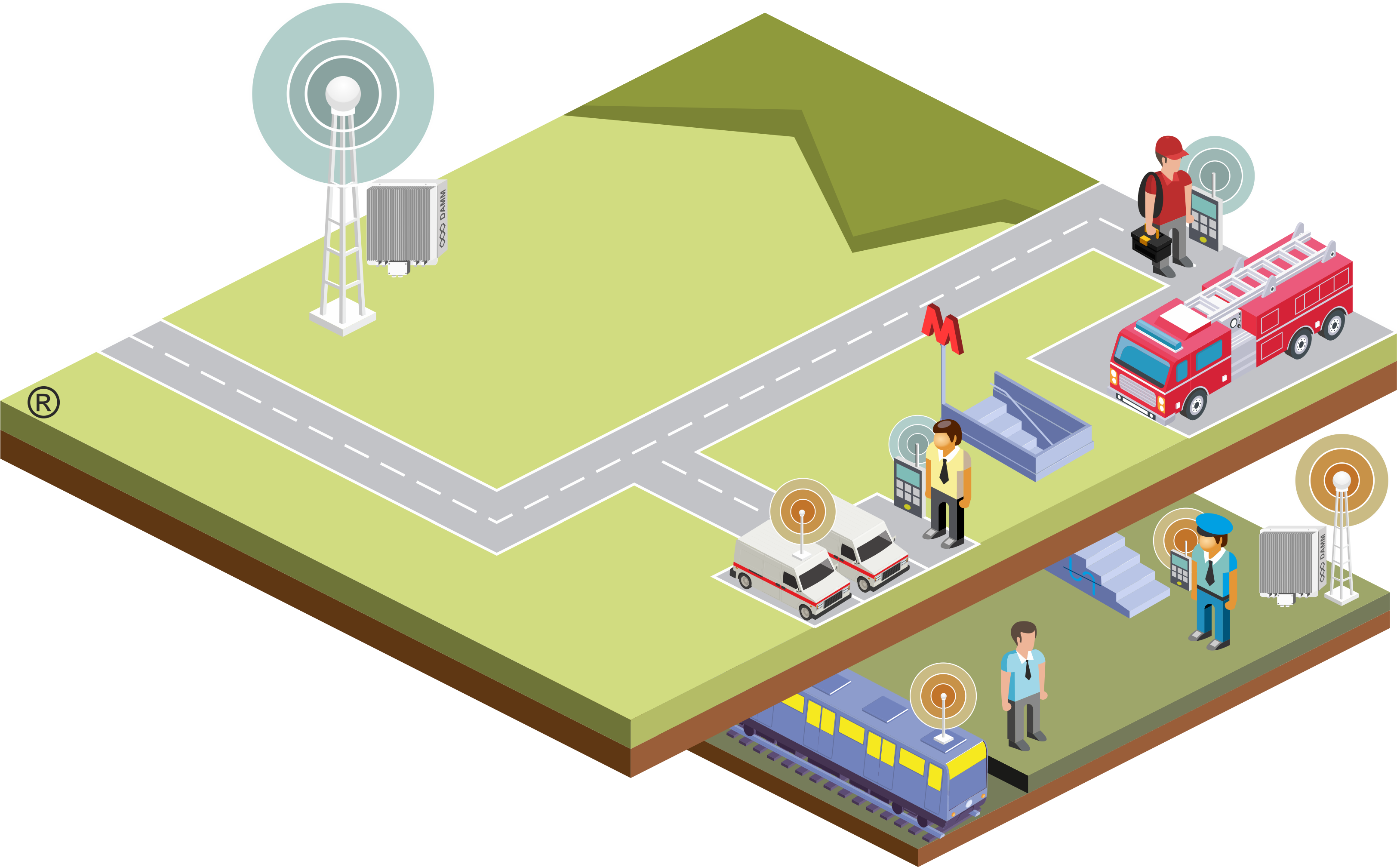The Metro or Rail is a transport facility with a high concentration of passengers and, as a result, a place of increased danger and a potential place for committing terrorist acts. Both types of transport serve as the backbone of the city’s public transport system, with guaranteed delivery times for passengers between different points in the city and suburbs. Thus, radio communication system can serve both transport and security purposes.
The solution used at the Metro and Rail facilities must be proven and reliable, and perform the functions assigned to it not only in a daily format, but also at peak load in conditions of mass events, emergencies or disasters.
Given its nature and size, there are multiple requirements for a professional radio system. The radio communication system must have:
– Non-blocking distributed architecture (without single point of failure);
– The maximum set of functionality among existing solutions, taking into account future extension;
– Support of data transmission from mobile terminals;
– Provide seamless handover of active calls;
– Ensure the simultaneous operation of many groups of subscribers with different priorities;
– Low power consumption;
– Ability to work in conditions of high humidity and temperature;
And, which is often more important for the maintenance:
– Low installation costs (equipment must operate in harsh operating conditions);
– Low operating costs with the ability to be serviced by qualified metro personnel.
It is not worth talking about the introduction of analog radio communications for each kind of the services (train control, maintenance or security) in such a noisy environment as in the Metro and Rail, the transmission of the clear subscriber’s voice is important.
There are several digital standards and technologies, which can be used for professional radio communications systems for Metro and Rail.
Worldwide, TETRA standard equipment for professional radio communications on the subway/metro has become actively used even while LTE is on the way.
Other standards and technologies for professional radio communications (e.g. DMR, Digital Mobile Radio) have not earned the trust of users for a number of reasons, including the lack of seamless handover, priorities, fixed (high) power emission of subscriber radios, heavy antenna-feeder system and limited supported services. This explains the active position of the TETRA standard as the main technology for professional radio communications in the Metro and Rail.
TETRA equipment has proven itself in multiple reflection conditions and is ideally works with radiating cable in Metro to provide seamless coverage in tunnels, stations and crossings. Depending on the required coverage area, a radiating cable of various sizes can be used. For example, Eupen RMC 114-T cable makes it possible to provide radio coverage in a subway tunnel at a distance of 2700 meters from the base station, even in conditions of strong electromagnetic interference.
The best of existing options for TETRA infrastructure is equipment from DAMM Cellular Systems A/S , name it “TetraFlex”.
The advantages of DAMM TetraFlex with a distributed architecture are widely covered in open sources, namely: low power consumption of all nodes, all-weather performance (IP65), Localized dispatcher interface, etc.
Depending on the area covered, subscriber capacity, it is possible to build up a TETRA system using only base stations (in Moscow, Almaty, etc.) or a System with repeaters (in Berlin). Of course, the cost of a solution with repeaters is lower than a solution with only base stations, but the first kind of system manageability is higher. Keep in mind that failure or routine maintenance on 1 base station can lead to the shutdown of the entire chain of repeaters.
Talking more about Metro. If it is necessary to cover underground areas at a distance of up to 20 km from the base station repeater with an optical interface can be used. The optical line budget (including cross-connect) should not exceed 12 dB. For example, optical systems from BHE. When connecting a radiating cable to an auxiliary (Slave) repeater, its radio coverage is reduced to 1400 meters in each direction (for RMC 114-T cable).
A typical solution for Metro and Rail should include the following equipment:
DAMM communication node – consisting of several BS421 or BS422 (transceiver, power at the antenna connector up to 25W), and up to 2x SB421 or SB422 (control and switching unit with built-in uninterruptible power supply);
Eupen RMC 114-T – radiating cable 1 ¼” section optimized for TETRA radio signal;
DAMM Dispatcher is a dispatch software package with a localized interface;
DAMM LogServer – a complex for recording negotiations and statistics;
VoIP-E1 – media gateway with E1 PR ISDN EDSS1 (or SS7) interface;
SEPURA STP9x, SC20x, SC21x, STP8x – TETRA portable radios;
SEPURA SRG3900, SCG2229 – mobile or fixed TETRA radios.
List of implemented projects with DAM infrastructure for Rail and Metro:
– Aurizon Rail Australia
– Moscow Metro Russia
– Riyadh Metro Saudi Arabia
– Fortescue Metals Group – Heavy Rail Australia
– Fortescue Metals Group – Heavy Rail – Second Spur Australia
– Nagpur Metro Rail Project India
– KRTC (Redline) Taiwan
– Mauritius Light Rail Trail (LRT) India
– Almaty Metro Kazakhstan
– LRMC Philipines
– KRTC (Orange Line) Taiwan
– Western Railway India
– Wuppertal Schwebebahn Germany
– MRT3 Philipines
– Eglinton Crosstown LRT (ECLRT) Canada
– Mumbai Mono Rail India
– Bavarian Zugspitz Cogwheel Railroad Germany
– Len Railways System Indonesia
– Finnish Government Railway Finland
– Samsun Light Rail System Turkey

